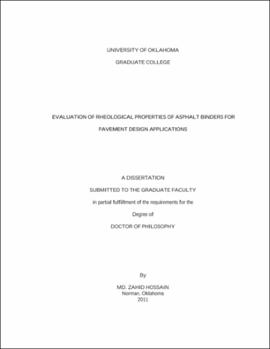| dc.contributor.advisor | Zaman, Musharraf | |
| dc.creator | Hossain, Zahid | |
| dc.date.accessioned | 2019-04-27T21:28:46Z | |
| dc.date.available | 2019-04-27T21:28:46Z | |
| dc.date.issued | 2011 | |
| dc.identifier | 99224270102042 | |
| dc.identifier.uri | https://hdl.handle.net/11244/318790 | |
| dc.description.abstract | More that 90% of the total paved roadways in the U.S. are asphalt concrete (AC) pavements. The annual expenditures for construction and maintenance of these pavements exceed $10 billion. To reduce these maintenance costs, it is crucial to design and construct pavements that perform well during its design life. Even though significant advances have been made in the analysis and design of hot mix asphalt (HMA) during the last two decades, pavement communities are still challenged with evaluating the performance of paving materials, in which the asphalt binder plays a significant role. Such challenges are getting augmented by the introduction on new paving technologies and materials such as warm mix asphalt (WMA) and recycled asphalt pavement (RAP). The main objectives of this study were to evaluate rheological properties of modified binders and predict the performance of the mixes. | |
| dc.description.abstract | The current study evaluated the effects of two commonly used anti-stripping (AS) agents (AD-here® HP Plus and Perma-Tac® Plus) on the rheological properties of a PG 64-22 binder. The optimal dosage of either of these AS agents was found to be 0.5%. The current study also evaluated the effects of different dosages two WMA additives (Advera® and Sasobit®) on the rheological properties of the PG 64-22 binder. The optimal dosage of Advera® was found to be 6%, which was not expected to change the PG grade of the base binder. While Advera® was found to be ineffective in reducing the viscosity at production temperatures, 3% Sasobit® was expected to reduce the mixing and compaction temperatures by 16oC and 19oC, respectively. Sasobit® was found to increase the stiffness of the binder. The optimal dosage of Sasobit® was found to be 1.5%. AS agent (AD-here® HP Plus) did not show any adverse impacts on the WMA-modified binder. It was also observed that binders recovered from three local RAP samples were found to be significantly stiffer than their virgin counterparts. The prolonged use of the centrifugal force and heat in the Abson recovery process was also found to harden the recovered binder. | |
| dc.description.abstract | The current study also developed an inventory of the mechanistic-empirical pavement design guide (MEPDG) input parameters for three binders collected from three refineries. The viscosity and stiffness of these binders were found to vary significantly from one source to another. The Witczak model, based on dynamic shear rheometer (DSR) test data of the binder, was found to underestimate the dynamic modulus (E*) values of mixes. The rotational viscosity data, however, overestimated the E* values. The Hirsch model, based on frequency sweep test data, was found to be a better-fit than the Witczak model. The estimated E* values of the Sasobit®-modified mix were found to be significantly higher than those of a control HMA mix. Distress factors of a typical pavement section estimated through the MEPDG software, predicted that about 40% of the total rutting would occur in the AC layers, of which 80% would occur in the surface course. It was also predicted that about 39% of total rutting would occur within two years of construction. The AC layers' rut depths were found to vary significantly with changes in binder type and source. Fatigue fracture, thermal cracking, and roughness were not found to be critical distresses in this study. The findings of this study are expected to provide pavement professionals a better understanding of the rheological evaluation of unmodified and modified binders for pavement design applications. | |
| dc.format.extent | 259 pages | |
| dc.format.medium | application.pdf | |
| dc.language | en_US | |
| dc.relation.requires | Adobe Acrobat Reader | |
| dc.subject | Pavements, Asphalt | |
| dc.subject | Binders (Materials) | |
| dc.subject | Asphalt--Rheology | |
| dc.subject | Asphalt--Additives | |
| dc.title | EVALUATION OF RHEOLOGICAL PROPERTIES OF ASPHALT BINDERS FOR PAVEMENT DESIGN APPLICATIONS | |
| dc.type | text | |
| dc.type | document | |
| dc.thesis.degree | Ph.D. | |
| ou.group | College of Engineering::School of Civil Engineering and Environmental Science | |
